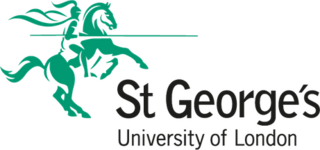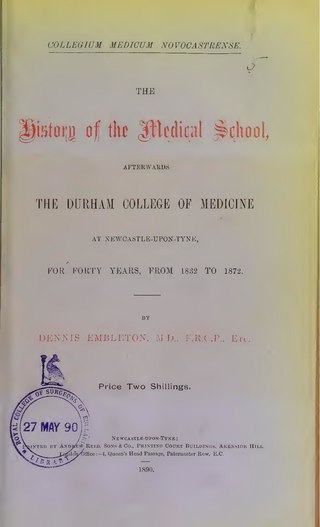Doctor of Medicine is a medical degree, the meaning of which varies between different jurisdictions. In the United States, and some other countries, the M.D. denotes a professional degree. This generally arose because many in 18th-century medical professions trained in Scotland, which used the M.D. degree nomenclature. In England, however, Bachelor of Medicine, Bachelor of Surgery (M.B.B.S.) was used and eventually in the 19th century became the standard in Scotland too. Thus, in the United Kingdom, Ireland and other countries, the M.D. is a research doctorate, honorary doctorate or applied clinical degree restricted to those who already hold a professional degree (Bachelor's/Master's/Doctoral) in medicine. In those countries, the equivalent professional degree to the North American, and some others' usage of M.D. is still typically titled Bachelor of Medicine, Bachelor of Surgery.
A medical school is a tertiary educational institution, professional school, or forms a part of such an institution, that teaches medicine, and awards a professional degree for physicians. Such medical degrees include the Bachelor of Medicine, Bachelor of Surgery, Master of Medicine, Doctor of Medicine (MD), or Doctor of Osteopathic Medicine (DO). Many medical schools offer additional degrees, such as a Doctor of Philosophy (PhD), master's degree (MSc) or other post-secondary education.

St George's, University of London, legally St George's Hospital Medical School, is a public university in Tooting, South London, England, and is a member institution of the federal University of London. In August 2024, St George's will merge with City, University of London to form City St George's, University of London.
A Bachelor of Medicine, Bachelor of Surgery is a medical degree granted by medical schools or universities in countries that adhere to the United Kingdom's higher education tradition. Despite the historical distinction in nomenclature, these degrees are typically combined and conferred together. This degree is usually awarded as an undergraduate degree, but it can also be awarded at graduate-level medical institutions. The typical duration for completion is five to six years.

The Royal College of Surgeons in Ireland (RCSI) is a not-for-profit medical professional and educational institution, which is also known as RCSI University of Medicine and Health Sciences. It was established in 1784 as the national body for the surgical branch of medicine in Ireland, with a role in supervision of training, and as of 2021 provides a broad range of medical education in multiple countries.

In the United Kingdom, medical school generally refers to a department within a university which is involved in the education of future medical practitioners. All leading British medical schools are state-funded and their core purpose is to train doctors on behalf of the National Health Service. Courses generally last four to six years: two years of pre-clinical training in an academic environment and two to three years clinical training at a teaching hospital and in community settings. Medical schools and teaching hospitals are closely integrated. The course of study is extended to six years if an intercalated degree is taken in a related subject.

The University of Birmingham Medical School is one of Britain's largest and oldest medical schools with over 400 medical, 70 pharmacy, 140 biomedical science and 130 nursing students graduating each year. It is based at the University of Birmingham in Edgbaston, Birmingham, United Kingdom. Since 2008, the medical school is a constituent of The College of Medical and Dental Sciences.

Brighton and Sussex Medical School (BSMS) is a medical school formed as a partnership of the University of Brighton and the University of Sussex. Like other UK medical schools it is based on the principles and standards of 'Tomorrow's Doctors', an initiative by the General Medical Council outlining the role of British practitioners. Since opening in 2003, BSMS has produced more than 1,500 new doctors who now work across the UK.

Keele University School of Medicine is a medical school located in Newcastle-under-Lyme and Shrewsbury. The first two years of the school's MBChB degree are mostly taught on the Keele University campus, while early contact with patients is critical, and there is significant interaction in a clinical environment from the second year onwards.

Newcastle University School of Medicine is the medical school at Newcastle University in England. It was established in 1834 in the city of Newcastle upon Tyne and served as the College of Medicine in connection with Durham University from 1851 to 1870 and then, as a full college of the university, Durham University College of Medicine from 1870 to 1937 when it joined Armstrong College, to form King's College, Durham. In 1963 King's College became the University of Newcastle upon Tyne. The university now uses the name "Newcastle University".

Deakin University's School of Medicine is based at the Waurn Ponds campus in Geelong, Victoria, Australia. It offers a four-year, graduate-entry, Doctor of Medicine (MD) degree.
Warwick Medical School is the medical school of the University of Warwick and is located in Coventry, United Kingdom. It was opened in 2000 in partnership with Leicester Medical School, and was granted independent degree-awarding status in 2007.

The University of Glasgow School of Medicine, Dentistry & Nursing is the medical school of the University of Glasgow, Scotland, and is one of the largest in Europe, offering a 5-year MBChB degree course. It is ranked 2nd in the UK for medicine by The Times Good University Guide 2018 and joint 1st in the UK by the Complete University Guide 2021. The School of Medicine uses lecture-based learning, problem-based learning and Glasgow's case-based learning.

The School of Clinical Medicine is the medical school of the University of Cambridge in England. The medical school is considered as being one of the most prestigious in the world, ranking as 1st in The Complete University Guide, followed by Oxford University Medical School, Harvard Medical School, and Stanford School of Medicine and 2nd in the world in the 2023 Times Higher Education Ranking. The Cambridge Graduate Course in Medicine (A101) is the most competitive course offered by the University and in the UK, and is among the most competitive medical programs for entry in the world. The school is located alongside Addenbrooke's Hospital and other institutions in multiple buildings across the Cambridge Biomedical Campus.

The Kaohsiung Medical University is a private medical school located in Sanmin District, Kaohsiung, Taiwan.

The University of Nottingham Medical School is the medical school of the University of Nottingham, Nottingham, UK. Its first intake of 48 students graduated in 1975. Student intake has steadily increased to a current level of 330 students per year, including 90 from the satellite graduate-entry school at Derby, which opened in 2003.
The University of Edinburgh Medical School is the medical school of the University of Edinburgh in Scotland and the United Kingdom and part of the College of Medicine and Veterinary Medicine. It was established in 1726, during the Scottish Enlightenment, making it the oldest medical school in the United Kingdom and the oldest medical school in the English-speaking world.

Swansea University Medical School is a medical school on Swansea University's Singleton campus. It is linked to additional teaching centres located throughout South and West Wales, including Cefn Coed Hospital, Singleton Hospital and Morriston Hospital in Swansea, Prince Philip Hospital in Llanelli, Withybush General Hospital in Haverfordwest and Bronglais Hospital in Aberystwyth. The Medical School also has a network of primary care teaching centers.
A Bachelor of Medical Sciences (BMedSci, BMedSc, BSc(Med), BMSc) is an undergraduate academic degree involving study of a variety of disciplines related to human health leading to an in depth understanding of human biology and associated research skills such as study design, statistics and laboratory techniques. Such disciplines include biochemistry, cell biology, physiology, pharmacology or psychosocial aspects of health. It is an equivalent level qualification to the more commonly awarded Bachelor of Science (BSc). Graduates may enter a diverse range of roles including post-graduate study, higher education, the biotechnology industry, the pharmaceutical industry, consultancy roles, scientific communication, education or unrelated disciplines which make use of the broad range of transferable skills gained through this degree.
The University of Ghana Medical School also UGMS is the medical school of Ghana's first public research institution, the University of Ghana. It is currently located at the Korle Bu Teaching Hospital in Accra. The medical school was first planned in 1919, but took its first students in 1962.














